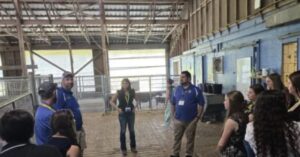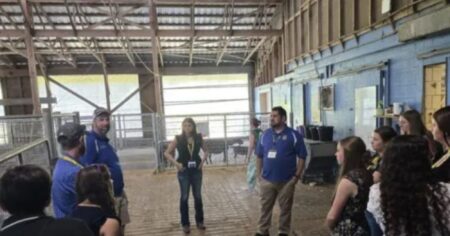Corn planting got off to an uneven start this April across top corn-growing states. Near-perfect conditions pushed some growers ahead, while persistent rain left others stuck on the sidelines.
Even within the same Corn Belt state, conditions have varied widely, creating a patchwork of progress across the region.
Here’s a look back at April, drawing on USDA’s first four Crop Progress reports of the season and insights from agronomists.
Iowa
Although corn planting in Iowa tracked with the five-year pace for the first couple weeks of April, the state’s corn planting surged the week ending April 20. Progress continued to follow that trend the following week.
“Once we got past the cold weather on Tuesday, April 8, field work really started to ramp up,” Logan Dinkla said in mid-April. Dinkla is a Syngenta agronomist covering much of west Iowa. At that time he said most of Iowa had favorable planting conditions and farmers were taking advantage of it.
However, Dinkla said things have slowed down in his region. “Rainfall the last two weeks has kept farmers out of the fields. The fields haven’t had the chance to dry out before receiving another rain,” Dinkla said on April 28.
Eric Wilson, a Wyffels agronomist supporting southern and northeast Iowa, described the varied progress in his territory on April 21. “Planting progress is significantly ahead of schedule in the southern parts of my area,” Wilson said. “As you go up into northeast Iowa, fewer growers have started and they are more on track with normal.”
But the “on track” progress in northeast Iowa is now facing rain delays. On April 28, Wilson said, “Recent heavy rainfall in northeast Iowa has slowed corn planting to a standstill. More rain in the forecast has growers waiting for soil conditions to get fit.”
Looking ahead, Wilson said significant progress is anticipated in the next 10 days in the northeast part of his state.
Illinois
Corn planting in the Prairie State has been behind the average pace all of April. The four Crop Progress reports from USDA so far this season show an ever-increasing gap between this year’s progress and the five-year trendline.
Phil Krieg, a Syngenta agronomist whose territory includes southern Illinois, has reported rain delays for most of April’s planting window.
Krieg said there was no planting activity the week ending April 13 because of saturated fields. There was a short window across southern Illinois between April 16 and April 18 where conditions were favorable for planting before the region saw more heavy rainfall. “Very little progress” was made after that, during the week ending April 27, Krieg said.
“Across the area, we need a favorable May to get back on track. No doubt the growers and retailers are nervous trying to plan on a workload that will be overwhelming,” Krieg said.
But the rain may not let up soon for southern Illinois. “More rain in the forecast for this weekend and next week is concerning,” Krieg said on April 25.
Ryan Gentle, a Wyffles agronomist covering much of western Illinois — farther north than Krieg — paints a different picture for his territory. Gentle said of the week ending April 20: “The green flag dropped last week for both [corn and soybeans] in west–central Illinois. Almost every field had some sort of activity going on. Conditions were close to ideal.”
As of April 20, Gentle said corn planting in his area was significantly ahead and growers were “feeling very good.” Up to an inch of rain during Easter weekend kept growers out of the fields until April 24, Gentle said. “It has been hot and heavy with tillage, spraying, and planting of both [corn and soybeans] since then,” he said.
Nebraska
Corn planting in Nebraska has largely been on track with the five-year trendline, according to USDA. Progress pulled ahead of the five-year average by a few points the week ending April 20, but the gap narrowed the following week.
Syngenta Agronomist Travis Gustafson has described ideal planting conditions in Nebraska for most of April.
Gustafson said in mid-April, “Weather has accelerated planting progress across Nebraska. We have ideal conditions and will probably be about seven days ahead of schedule, as far as planting progress goes for 2025.”
However, continued dry conditions affected the pace. “While we have had excellent conditions for planting, planting activity has lagged behind the conditions but remains on pace with the calendar. It has been very dry lately, and people may be waiting for rain so they don’t have to turn on irrigation to water up the crop,” Gustafson said on April 21.
Earlier this week, Gustafson described some regional variability in Nebraska’s corn planting. For the week ending April 28, Gustafson said, “Corn planting in Nebraska has been progressing along quickly. Many parts of central Nebraska have had good planting conditions and have seen roughly 25% of corn acres planted in the past week. Eastern Nebraska has had a few more showers and [rainy] weather move through, so the progress in the eastern part of the state is lagging behind the central part of the state.”
Minnesota
Corn planting in Minnesota has jumped ahead of normal pace in the last couple weeks, after a typical slow start in the first part of April.
“Corn planting took off across Minnesota the week [ending April 21] but was brought to a halt across the eastern two thirds of the state due to April rains,” Tim Dahl said. Dahl covers southern Minnesota as an agronomist for Syngenta.
For that time period, Dahl described variable progress in his territory: “Planting progress really depends on where ground is located in Minnesota. The western part of Minnesota is close to being on track, with the east beginning to fall a bit behind.”
Dahl said progress continued to vary during the week ending April 28 because of uneven rainfall totals across the state. “In the western part of Minnesota, things are progressing right along, while the east half of the state is just drying off and getting fit,” Dahl said.
Jared Goplen, a Wyffels agronomist whose territory includes part of southern Minnesota, reported the same. Growers in southwest Minnesota “continued to plant corn throughout the week last week and have made excellent progress, with a decent number of farms wrapping up with corn planting,” Goplen said on April 28. But in central Minnesota, more consistent rains “have kept most out of the field,” he said.
Indiana
Indiana’s corn planting has lagged behind normal most of April by a few percentage points.
Chad Threewits, a Syngenta agronomist covering the state of Indiana, said his territory received 2–6 inches of rain the first week of April, noting at the time, “Planting will not start for a while now.”
By April 20, Threewits said that “Warm, windy weather really helped dry things out, but rain on April 18 was fairly widespread.” He expected at the time that it would put things on hold for a few more days.
Earlier this week, Threewits reported more rain in parts of the state that will cause more delays. For the week ending April 27, Threewits said, “Rain put a halt to planting in many areas, but northeast Indiana missed it. Some areas in east-central Indiana received 3–4 inches and will not be getting started yet.”
Wisconsin
In the Badger State, corn planting progress is off to a slow start as expected. Yet progress is pulling increasingly ahead of average, according to USDA.
Wisconsin agronomist Nick Groth said there was “very little planting activity” the week ending April 13, but corn planting “got rolling in Wisconsin” the week ending April 20. Weather put a halt to the progress though. “The end of the week and through the weekend brought wet weather and cooler temps, so the flurry of activity was short lived,” Groth said.
Earlier this week, Groth said, “[The week ending April 27] was fairly cool, and there were enough spotty showers to slow planting progress for the first half of the week. But by the middle to end of the week, and certainly through the weekend, conditions really improved.”
“We are in a really good planting window right now, with pretty good field conditions and better temperatures in the forecast,” Groth said. “A lot will depend on how much rain we get with the next system that comes through, and potentially one later in the week.”


:max_bytes(150000):strip_icc()/101177215_corn-bfe8f2d01df240d9a8697b7535293fab.jpg)

:max_bytes(150000):strip_icc()/8455823819_6bc057daab_o-576d72839f17401baa860d460b694e3e.jpeg)


:max_bytes(150000):strip_icc()/Spring-Planting2-1-2000-c94ef958191e45318b85af10dfdc0453.jpg)

:max_bytes(150000):strip_icc()/soybeans-closeup-landscape-1-2000-a25d6239d4194b0891ee85db842aee1f.jpg)
:max_bytes(150000):strip_icc()/AnadoluContributor-2222721884-08d3d641d69848538327950a86625add.jpg)
:max_bytes(150000):strip_icc()/Markets-1-Corn-dramatic-up-3-e315aad20b8b47d0896df23c5bc95e11.jpeg)